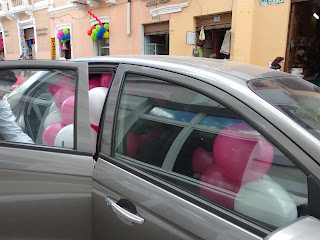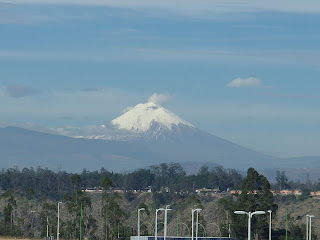The old historic district of Quito is an area of about a square mile. Within the area there are over twenty churches and convent chapels. Each religious order built at least one church for their particular order over a period of 200 years. Construction of the oldest church, San Francisco, was begun in 1542. The newest, the Merced church, was started in 1742. The Avenida Garcia Moreno is known as the "street of the seven crosses" for the crosses along its length, placed to remind citizens to embrace piety. The photo quality of the church interiors was effected by a "no photos" edict.
 |
| San Francisco Church and Plaza. The Oldest Church in Quito |
 |
| The Adjacent Catuna Chapel. Legend has it that the Builder, an Indigenous Man Named Catuna, Was Behind Schedule and Sold His Soul to the Devil to Help Him, Payment Due Upon Completion. The Chapel Was Never Quite Finished. |
 |
| Exterior of the Jesuit La Compania de Jesus Church, With an Extrordinary Elaborate Facade and an Even More Elaborate Interior |
 |
| The Altar of La Compania. The Interior Decoration Supposedly Contains Seven Tons of Gold. |
 |
| The El Sagrario Church, Originally the Main Chapel for the Cathedral |
D
 |
| Doors of El Sagrario, Carved by Famous Indigenous Artist Bernardo de Legarda. It Took Him 17 Years. |
 |
| The St. Augustine Church |
 |
| Beautifully Painted Interior of St. Augustine Church |
 |
| The Merced Church. The Newest in the Historic Area (1742) |
 |
| First Communion Being Celebrated at the Merced Church |
 |
| The Chapel at the El Carmen Alto Convent |
 |
| The Cloistered Carmelite Nuns Sell Their Traditional Handmade Products (Cookies, Wine, Rose Water, etc. List on the Left) Through this Turnstile |
 |
| Birds on a Cross |
We also paid a visit to one of Quito's "newer" churches. The Basilica of the National Vow (
del Voto Nacional), located about eight steep blocks up from the center of the historic area (we took a taxi). Construction of the Basilica began in 1887 and in 1895 the government instituted a tax on salt to continue building. The structure is the largest neo-Gothic church in the Americas. It is technically "unfinished" since legend has it that the end of the world will come when the building is completed. We arrived in the sanctuary to find that a special feast day was being celebrated, so witnessed the procession of the Archbishop and accompanying clergy, to the applause of the congregants.
 |
| Towers of the Basilica |
 |
| Interior |
 |
| Rose Window With Some Missing Panes |
 |
| Archbishop's Arrival |
Mass was being said, accompanied by guitars and soloists, and as the Archbishop began his homily we took an elevator up to the church's towers. A catwalk crossed over the tops of the Gothic arches led to a ladder, which could be climbed nearer the top of the towers. We abstained.
 |
| Catwalk |
 |
| Non-Functioning circa 1912 Organ, On Display Up in the Towers |
The church has gargoyles, as is usual in
Gothic architecture, but these are of native Ecuadorean animals.
 |
| Tortoise |
 |
| Iguanas |
 |
| Birds |


































































